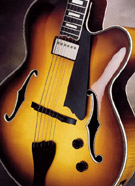 |
James L. Mapson Guitars
Handcrafted Archtop Guitars
|
3230 South Susan Street Santa Ana, CA 92704 Tel: 714-754-6566 |
PRODUCT
REVIEW
|
Jim Mapson's Lusso Archtop
|
| Price List Click Here for Current Prices |
 |
The Guitar It is a Lusso electric model with a 17" body which is 3 1/4" deep, and a 25 1/2"scale. The hand carved top is of Colorado Blue Spruce which tapers from 3/4" thick in the pickup area to 3/8" down the center. The parallel struts are carved out of the top and it has a built-in pickup. The volume and tone controls are also cut into the body. The back and sides are maple and the F-holes, neck and fingerboard are bound with grained ivoroid binding. The tailpiece, pick-guard, fingerboard, bridge, truss rod cover and pickup surround are made of ebony. The headstock has an ebony front plate and ebony/maple/ebony rear veneer, with a diamond solitaire inlay front and rear. The neck is thicker on this guitar, similar to the necks on 50's Gibsons and Guilds, which is my personal preference. It is also graphite reinforced, with adjustable truss rod. The ebony fingerboard has mother of pearl block inlays and side dots. Finding a luthier that would really listen to my thoughts, rather than having to settle with a modified pre-existing model, was the real key to success. It is a collaboration of ideas between Jim and myself that has produced this instrument which is extremely innovative, e.g. in having the thick top and the parallel struts carved out of the top. These ideas may not be so unusual, but Jim's idea with the back is something quite special. The back of the guitar is what takes the stress of the string tension and also plays an important part in generating the tone of the guitar. Therefore it is doing two jobs, but cannot do both efficiently. Jim, in his studies, came across the idea of adding a stabilizing strut between the heel and the tail block, situated close to the back. The strut then absorbs the string tension, allowing the back to vibrate freely and act as it should do in producing tone. Jim was losing a lot of sleep worrying about this guitar, as it was not only different to those he had built before, but broke all the rules that a luthier sets out for himself. The big day came and the guitar was ready for stringing. To begin with, Jim strung the guitar up without the electrics, and to his amazement it was as loud as any of the acoustics he had built. The electrics were installed and the guitar was still loud acoustically. Another interesting point was that when tuning the guitar with a tuner, as each string came into pitch the needle stayed static, no wavering. Electrically the guitar gives a very thick sound and is very balanced across the strings. In my opinion and everyone who has played the guitar, it has a very solid feel and fantastic sound. A truly great instrument! Luthier's Sidenote: 07/Feb/98 In Trefor's case, he had come across several guitars in his past that had traits he admired, as well as problems he wished to avoid. His Koontz had many great traits including a rather thick top, but suffered from neck stability problems when on the road. He also liked the Knight archtop in his past, which had 'carved in place' rather than 'glued in' parallel bracing, and produced wonderful tone. His L5 from the early 50's had great balance and a neck profile that felt just right to his taste. Also, electric performance with minimal feedback was of paramount importance. Armed with Trefor's input, I could then proceed with the design phase. The difficulty would be in creating an instrument that could stand up to the travels of a working artist, produce great electric tone, and look traditional on the outside. I additionally set the personal challenge of creating a pleasant acoustic tone which seemingly went against logic considering the extremes of a very thick parallel braced top and top cut-in pickup and controls. I wanted to also produce a neck with long term stability as well as improve sustain. This pointed to carving the back plate very thick or adding braces along it's center to support the lower portion of the neck block. However, my only chance to improve the acoustics would be to free up the back, which is responsible for warming up the midrange and producing the bass tones. I would have to find a way to displace the load carrying task of the back, in order to maximize it's tone producing function. I recalled that the Larson Brothers devised a somewhat complicated means using metal bars to position and stabilize the necks in their Prairie State flat-top instruments, and were awarded a patent in 1930 for their efforts. 1 felt a more simple approach could work with this instrument, and used a maple strut to anchor the bottom of the neck block to the tail block. Floating free just below the strut, the back would now be relieved from much of it's load bearing duty, and I was free to tap-response optimize (tap tune) the 20 year old domestic maple back. To my delight, the guitar is both warm with good projection acoustically, and accepts any increase in attack without breaking up. The neck has proven to have great sustain and remained in tune thru a 3 set gig on its debut performance, Tuesday of LA NAMM Guitar week at Papashon, less than I week after it's initial stringing up. My thanks to Mr. Trefor Owen, for sharing his design ideas with me, as well as taking a chance with a new luthier. James L. Mapson Just Jazz Guitar - May 1998 |
| Guitar Models Avante Bop City Jazz Bandit Jazz Standard Lusso Solo |